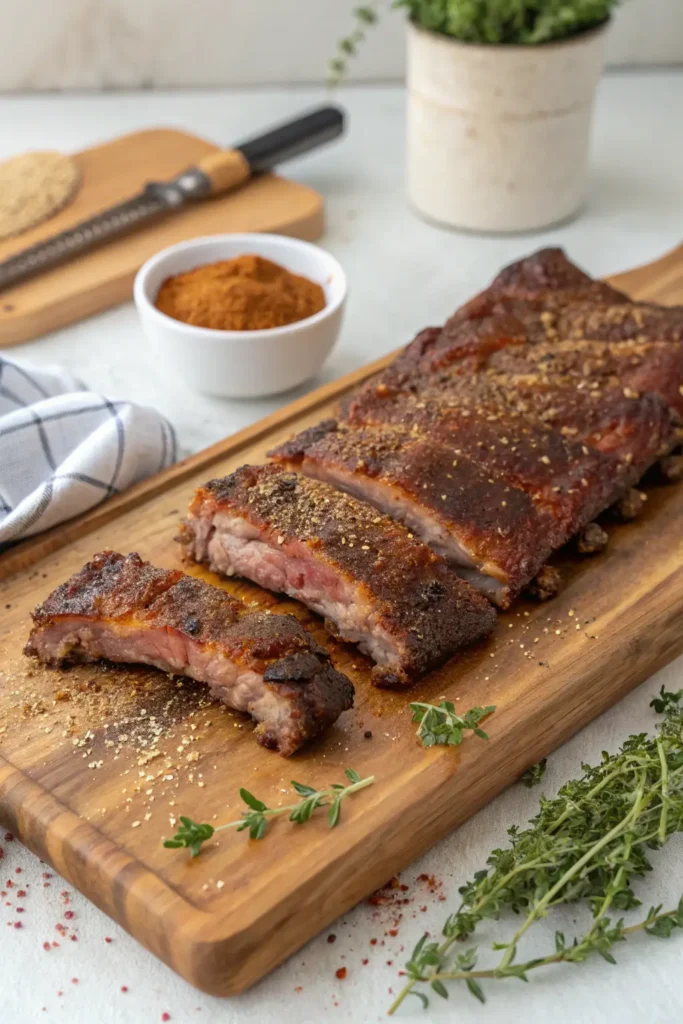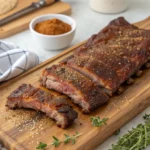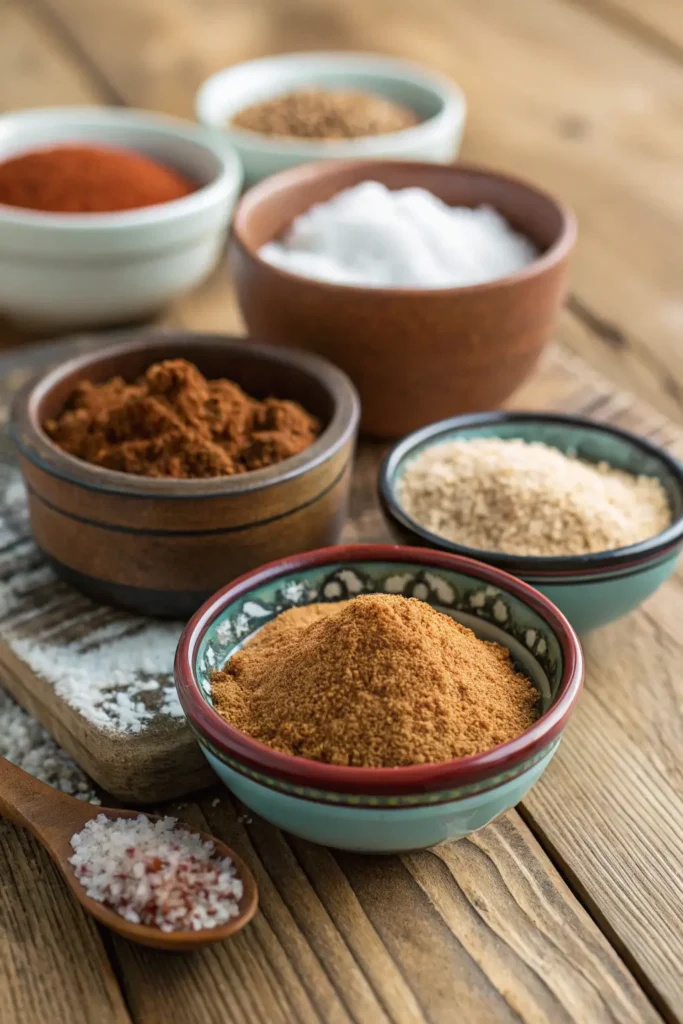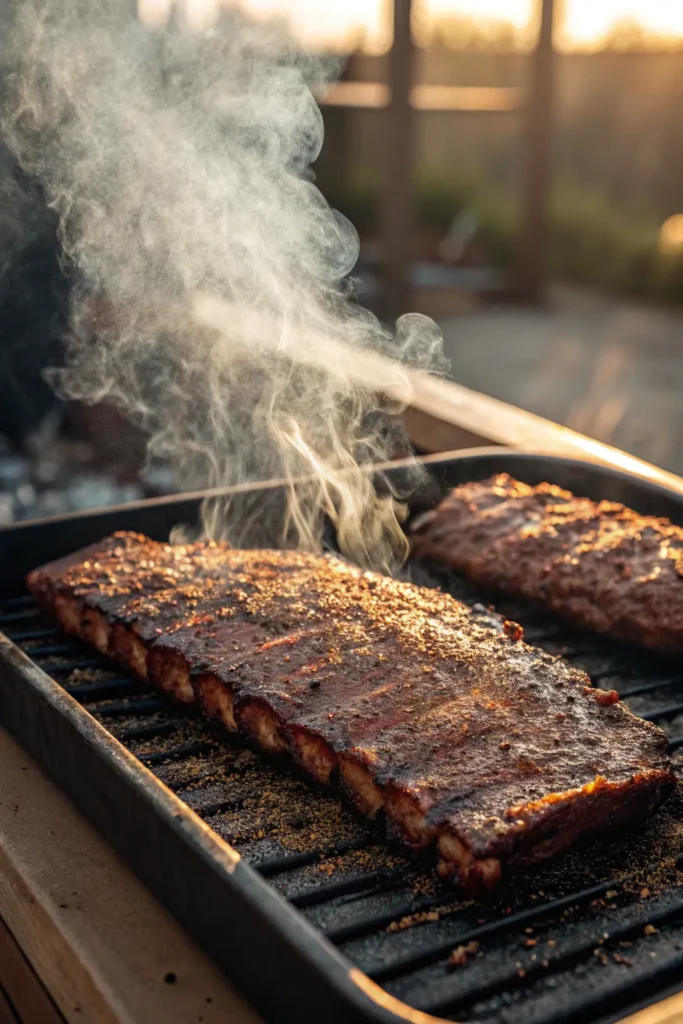When it comes to crafting ribs that taste like they came straight from a pitmaster’s smoker, one element makes all the difference: a well-balanced dry rub for ribs. Whether you’re grilling outdoors, slow-cooking indoors, or firing up the smoker, the right rub can take your ribs from decent to unforgettable.

A good dry rub for ribs forms a flavorful crust, locks in moisture, and enhances the natural taste of the meat. It’s the perfect way to bring out deep, smoky, sweet, and savory flavors—all without relying on sauce. If you’re after ribs with a bark that bites back, it all starts with seasoning.
This comprehensive guide covers everything from the essential ingredients in a dry rib rub to expert tips on application, timing, and variations. You’ll also get answers to the most frequently asked questions to help you master every rib you make.
Print
Best Dry Rub for Ribs
- Total Time: 10 minutes
- Yield: 10 servings 1x
Description
This dry rub for ribs will amplify the flavor on any rack of ribs you cook. I’ve packed classic BBQ flavors into my rib rub recipe so you get finger-licking results!
Ingredients
- ¼ cup dark brown sugar
- 1 tablespoon kosher salt
- 1 tablespoon chili powder
- 1 teaspoon cumin
- 1 teaspoon garlic powder
- 1 teaspoon onion powder
- 1 tablespoon paprika
- 1 teaspoon black pepper
- 1 teaspoon mustard powder
Instructions
- In a bowl, combine all the spices and seasonings, stirring until the blend is well mixed.
- Dry the ribs, then season with dry rub liberally, rubbing it into the ribs for maximum flavor.
- After the ribs have rested for at least 30 minutes (overnight for deeper flavor), grill, smoke or bake until tender and caramelized.
Notes
- Adjust the Spice Level — To make your rub spicier, add an extra ½ teaspoon of cayenne or black pepper for more heat.
- Batch It Up – This rub keeps well in an airtight container in a cool, dark place for up to 6 months, so make a big batch and have it on hand for future BBQs.
- Prep Time: 5 minutes
- Cook Time: 5 minutes
- Category: Appetizer
- Cuisine: American
Nutrition
- Calories: 59kcal
- Sugar: 11g
- Sodium: 1072mg
- Fat: 1g
- Saturated Fat: 0.1g
- Carbohydrates: 14g
- Fiber: 1g
- Protein: 1g
Keywords: dry rub, dry rub for ribs, seasonning
PART 1: Why a Dry Rub for Ribs is a Game-Changer
What is a Dry Rub and Why It Works for Ribs
A rib dry rub is a flavorful blend of spices, herbs, salt, and sugar that’s rubbed onto the meat’s surface to season it before cooking. Unlike wet marinades, which soak in and add moisture, a dry rub sticks to the outside of the ribs and helps form a flavorful crust that seals in juiciness and adds incredible depth.
The beauty of a good dry rub for ribs is that it enhances the natural flavor of pork while adding smoky, sweet, and savory notes. As the ribs cook—especially low and slow—the rub caramelizes, forming a crust that’s rich, sticky, and irresistible. This bark is what sets exceptional ribs apart from average ones.
Table of Contents
Benefits of Using Dry Rub Over Marinades or Sauces
While sauces and marinades have their place, nothing beats the impact of a dry rub, especially when cooking ribs. Here’s why so many pitmasters rely on dry rubs for ribs:
| Feature | Dry Rubs | Marinades/Sauces |
|---|---|---|
| Flavor Depth | Penetrates the surface, enhances crust | Mostly adds moisture and acidity |
| Texture | Builds a caramelized bark | Can become sticky or soggy |
| Prep Time | Quick to mix and apply | Requires longer marination |
| Versatility | Perfect for grill, oven, smoker | Often used last-minute |
A thoughtfully crafted dry rub for ribs doesn’t just season—it transforms. You’re not covering up the meat; you’re drawing out its very best qualities. And once you try ribs with a proper rub, it’s hard to go back.
PART 2: Key Ingredients in a Classic Dry Rub for Ribs
The Role of Sugar, Salt, and Spices in Flavor and Texture
A truly great dry rub for ribs begins with the perfect blend of sweet, salty, and spicy components. This combination is what creates that signature bark—a crust that holds in juices and delivers bold BBQ flavor with every bite.

- Dark Brown Sugar – It’s the base of most rib rubs, offering sweetness that caramelizes into a sticky, crave-worthy coating.
- Kosher Salt – Enhances overall flavor, draws out excess moisture, and contributes to a rich, juicy texture.
- Black Pepper – Gives a sharp, peppery contrast to the sweetness, creating complexity.
- Smoked Paprika – Brings out a rich color and delivers a mild smokiness that’s perfect for barbecue.
- Garlic Powder & Onion Powder – Provide deep umami and aroma, the flavor backbone of many spice rubs.
- Chili Powder – A touch of heat and earthiness that rounds out the seasoning profile.
Together, these ingredients form the core of a well-balanced dry rub for ribs that works whether you’re smoking, grilling, or roasting. Each element enhances the flavor and ensures that the meat cooks evenly with a flavorful outer crust.
Top Secret Additions: Celery Salt, Cinnamon, and Mustard Powder
What separates a decent rub from a mind-blowing one? The secret ingredients that add depth and character without being obvious.
- Celery Salt – Offers an earthy bitterness that complements the sweetness and deepens the flavor.
- Cinnamon – Adds a subtle warmth and an intriguing twist people can’t quite identify—but love.
- Mustard Powder – Brings acidity and brightness, helping cut through fatty cuts like ribs.
These additions make your dry rub for ribs stand out at backyard BBQs or competitions. They don’t overpower—they enhance, blending with the core spices for a balanced, finger-licking finish.
Don’t miss our air fryer beef jerky for another creative way to put spice blends like this to work.
If you’re serious about flavor, building your own dry rub for ribs ensures every bite delivers the exact punch of sweet, spicy, and savory goodness you’re after.
PART 3: How to Make the Best Dry Rub for Ribs at Home
Simple Homemade Rib Rub Recipe with Substitutions
Making your own dry rub for ribs at home is incredibly easy—and way more flavorful than most store-bought blends. You control the heat, the sweetness, and every note in between. Here’s a tried-and-true recipe that balances classic BBQ flavors with bold, customizable twists.
Basic Rib Rub Recipe
| Ingredient | Amount |
|---|---|
| Dark Brown Sugar | 1/2 cup |
| Kosher Salt | 2 tablespoons |
| Smoked Paprika | 1 tablespoon |
| Black Pepper | 1 tablespoon |
| Garlic Powder | 1 tablespoon |
| Onion Powder | 1 tablespoon |
| Chili Powder | 1 tablespoon |
| Mustard Powder | 1 teaspoon |
| Ground Cumin | 1 teaspoon |
| Celery Salt | 1/2 teaspoon |
| Ground Cinnamon | 1/2 teaspoon |
Instructions:
- Mix all ingredients thoroughly in a medium bowl.
- Keep in a sealed, airtight container in a cool, dry spot and use within 6 months for best quality.
.
Optional Substitutions:
- Swap chili powder for cayenne if you like more heat.
- Use regular paprika if smoked isn’t available.
- Add dried thyme or oregano for a herbal twist.
This blend is ideal not just for ribs, but for pork chops, grilled chicken, or even roasted potatoes. After tasting this homemade blend, store-bought rubs just won’t compare.
Mixing, Storing, and Scaling the Recipe
Once you’ve combined your spices, storing your dry rub for ribs the right way will ensure it stays fresh and potent for months.
Pro Tips:
- Use a glass jar or spice container with a tight seal.
- Label the container with the name and date mixed.
- Store it away from direct light and heat to maintain its full flavor and fragrance.
Scaling the Recipe:
Want to make a big batch? Just multiply the measurements evenly. A double batch is perfect for rib lovers who grill often or cook for large crowds.
With your signature dry rub for ribs ready and sealed, you’ll always have a quick flavor weapon on hand—whether it’s for weekend barbecues or weeknight oven-baked ribs.
PART 4: Applying Dry Rub Like a Pitmaster
Preparing the Ribs: Drying, Trimming, and Membrane Removal
Before the dry rub for ribs even touches the meat, proper prep is essential. This step ensures that the seasoning adheres fully and penetrates deeply for maximum flavor.
1. Dry the Ribs
Use paper towels to blot the ribs thoroughly. Too much moisture can prevent the rub from sticking properly, causing it to slip off the meat.
2. Trim Excess Fat
Remove loose or heavy pockets of fat. While some fat is good for flavor, too much will cause flare-ups and inconsistent cooking.
3. Remove the Membrane
Flip the ribs bone-side up and look for a silvery-white membrane. Slide a knife underneath and pull it off using a paper towel for grip. This step allows the dry rub for ribs to seep into every fiber instead of being blocked by that tough skin.
Taking time with this stage is the difference between “pretty good” ribs and unforgettable ones.
To Mustard or Not? Using a Binder Before Dry Rub Application
One of the most common questions in BBQ circles: Should you apply mustard before the rub?
The answer? It’s optional—but highly recommended.
Why Use a Binder?
Brushing on a light coat of yellow mustard or olive oil helps the seasoning adhere evenly to the ribs. It doesn’t affect the flavor, but it promotes better bark formation and consistency across the rack.
Here’s how to do it right:
- Spread a light coat of yellow mustard over the entire surface.
- Generously sprinkle the dry rub for ribs over every inch—both sides and the edges.
- Gently pat (don’t rub) the seasoning into the meat so it adheres without clumping.
Want to try this approach on another protein? Check out our crockpot steak and potatoes for a slow-cooked dish where seasoning technique also makes a big impact.
Using a binder isn’t required, but once you see how it boosts flavor adhesion and creates that golden crust, you might never skip it again.
PART 5: Timing It Right — How Long Should Dry Rub Sit on Ribs?
Quick Rub vs. Overnight Rest: Pros and Cons
Timing matters when applying your dry rub for ribs. Whether you’re short on time or planning ahead, how long you let the rub rest makes a major difference in taste and texture.
Here’s a breakdown of both approaches:
| Timing | Flavor Impact | Texture Result |
|---|---|---|
| 30 Minutes | Light surface seasoning, good for last-minute prep | Mild crust, decent flavor |
| 2–4 Hours | Deeper flavor penetration, more balanced seasoning | Slightly firmer bark with more developed taste |
| Overnight (8–12h) | Full flavor saturation, max impact from salt and spices | Best bark and boldest flavor |
If you’re after quick weeknight ribs, a short rest still works. But if you’re cooking for a weekend BBQ or competition-level results, let your dry rub for ribs sit overnight in the fridge. The salt will start to tenderize the meat, and the spices have time to meld with the surface.
Best Practices for Refrigeration and Flavor Penetration
When refrigerating ribs overnight with a dry rub, here’s how to do it right:
- Wrap Tightly – Use plastic wrap or a zip-top bag to keep air out and rub in contact with the meat.
- Keep It Cold – Store in the coldest part of the fridge, ideally below 40°F.
- Bring to Room Temp – Before cooking, let the ribs sit out for 30 minutes. This ensures even cooking and helps preserve the rub’s texture.
For best results, think of the rub like a marinade that doesn’t require liquid. Time enhances everything.
PART 6: Cooking Methods That Maximize Dry Rub Flavor
Smoking, Grilling, and Oven-Baking Techniques
Once you’ve applied your dry rub for ribs, it’s time to cook them to tender perfection. However, the technique you use can greatly influence the final result. From backyard smokers to indoor ovens, each technique offers a unique texture, flavor intensity, and bark formation.

1. Smoking
The gold standard for BBQ ribs. When slow-smoked at low temperatures (225°F), the rub melds with the meat to form that crave-worthy bark and deep smoke flavor.
- Ideal wood: Hickory, applewood, or cherry.
- Time: 5–6 hours depending on thickness.
- Tip: Wrap in foil after 3 hours to prevent drying out.
2. Grilling
Grilling gives your dry rub for ribs a charred finish with a touch of crispiness. Indirect heat is key.
- Setup: Use a two-zone fire (hot/cool sides).
- Cook Time: 1.5–2 hours over indirect heat.
- Tip: Avoid flipping too often to preserve the rub crust.
3. Oven-Baking
Don’t have a smoker? No problem. Baking delivers tender ribs with rich flavor when done low and slow.
- Temperature: 275°F.
- Time: 2.5–3 hours, wrapped in foil.
- Final Step: Broil for 5–10 minutes to create a caramelized crust on the rub.
Whichever method you choose, the dry rub for ribs does most of the heavy lifting when it comes to flavor. Cook slow and low, and let the seasoning shine.
Using Dry Rub in the Slow Cooker for Fall-Off-The-Bone Ribs
Short on time but still want rich BBQ flavor? The slow cooker is your best friend—and yes, your dry rub for ribs works perfectly here too.
Here’s how to do it:
- Apply the Rub generously and press it into the meat.
- Add a Splash of Liquid—like broth, apple juice, or cider vinegar—for moisture.
- Cook slowly on low heat for 6 to 8 hours, or until the meat is fork-tender.
- Place it under the broiler briefly to create a crispy top and deepen the flavor of the rub.
This method is hands-off but still delivers juicy ribs packed with flavor. It’s especially useful in colder months when grilling isn’t an option.
Looking for inspiration? Try our crockpot steak and potatoes to see how low and slow cooking brings out big flavor with the help of a good seasoning blend.
PART 7: Variations of Dry Rub for Different Flavor Profiles
Sweet & Spicy, Coffee-Boosted, and Asian-Inspired Versions
Once you’ve nailed the classic dry rub for ribs, it’s time to get creative. Tweaking your spice blend can unlock bold, new dimensions of flavor. Whether you prefer extra heat, deep richness, or global inspiration, these variations keep your BBQ game exciting.
1. Sweet & Spicy Kick
Perfect for those who love the contrast of heat and sugar.
- Add 1 tsp cayenne pepper for real heat.
- Use smoked paprika instead of regular for deeper BBQ flavor.
- Increase brown sugar slightly for extra caramelization.
Best For: Pork ribs on the grill or smoker, paired with coleslaw or baked beans.
2. Coffee-Infused Rub
A deep, robust flavor that intensifies the meat’s savory richness.
- Add 1 tbsp finely ground coffee.
- Substitute regular salt with smoked salt if available.
- Works best when slow-smoked or oven-baked.
Flavor Notes: Bitter-sweet, earthy, and robust. Fantastic with a bourbon glaze or bold red wine.
3. Asian-Inspired Rib Rub
Give your dry rub for ribs an East-meets-West twist.
- Swap mustard powder for 1 tsp ground ginger.
- Add ½ tsp Chinese five-spice for aromatic sweetness.
- Include a pinch of white pepper for subtle heat.
Flavor Boost: For a glossy, flavorful finish, baste the ribs with a soy and honey glaze during the final 15 minutes of cooking.
Herb-Infused Blends and Regional BBQ Styles
For more nuanced or region-specific styles, try adding herbs and localized flavors to your rub:
1. Herb-Infused BBQ Rub
For a more aromatic flavor that pairs well with roasted meats:
- Add 1 tsp each of dried oregano, rosemary, and thyme.
- Use coarse sea salt for texture.
- Best for oven-baked ribs or pork chops.
2. Memphis-Style
Dry, savory, and spice-forward with less sugar.
- Use more paprika and black pepper.
- Reduce brown sugar to a tablespoon or skip it.
- Emphasize garlic and celery salt.
3. Texas-Style
Simple, bold, and smoky.
- Focus on equal parts salt and pepper.
- Add smoked paprika and chili powder.
- Skip the sugar entirely for a savory, meat-driven profile.
Check out our crispy honey chicken for another twist on flavor profiles using a sweet base and spice to deliver impact.
With these variations, your dry rub for ribs becomes a customizable flavor canvas. Whether you want bold heat, smoky sweetness, or herbal complexity, there’s a blend to match your taste.
PART 8: Beyond Ribs — Creative Ways to Use Rib Rub
Pork Chops, Chicken, and Roasted Veggies
While this blend is called a dry rub for ribs, its versatility makes it a secret weapon in your spice cabinet. You don’t need to wait for a rack of ribs to use this bold seasoning—there are plenty of ways to repurpose it for weeknight meals and backyard feasts.
Pork Chops
Work the rub generously into thick-cut chops, allowing them to rest for 15–30 minutes to absorb the flavor. Then sear over medium heat on the stovetop or grill for a mouthwatering finish. The caramelized crust created by the sugar and spices is out of this world.
Chicken Thighs or Drumsticks
Pat chicken dry and coat with the rub before baking or grilling. Add a touch of olive oil for better adhesion. It forms a delicious, golden skin that makes every bite burst with flavor.
Roasted Vegetables
Yes, you read that right. Sprinkle your dry rub for ribs on sliced potatoes, carrots, or sweet potatoes before roasting. It gives the veggies a smoky, sweet-savory kick that turns them into a main event.
All-Purpose Seasoning Tips for Everyday Use
When made in batches, this rub becomes an everyday flavor enhancer. Make it part of your everyday flow with these simple steps
- As a Dry Marinade – Rub onto beef or pork a few hours before grilling.
- In Burgers – Mix a teaspoon or two directly into your ground beef before forming patties.
- On Fries or Popcorn – Dust it lightly over fresh fries or warm popcorn for a smoky, sweet snack.
- In Sauces or Dips – Stir a spoonful into ketchup, mayo, or sour cream for a spicy dip or smoky spread.
Just be sure to label and date your spice mix jar, and keep it away from light and moisture. When stored properly, a homemade dry rub for ribs retains its flavor for up to six months.
You’ll find yourself reaching for it far more often than you expected.
PART 9: Make-Ahead, Storage, and Reheating Tips
Storing Dry Rub and Leftover Ribs
A homemade dry rub for ribs is perfect for batch prep. It stores beautifully and keeps your spice cabinet stocked with flavor for months.
Storage Tips for the Dry Rub:
- Use an airtight container like a spice jar or mason jar with a tight seal.
- Label and date your mix. Spice potency fades over time.
- Store in a cool, dry place away from direct heat and light to maintain its essential oils and aroma.
When stored correctly, your rub stays fresh and flavorful for up to 6 months. Avoid dipping wet spoons into the jar to prevent clumping or spoilage.
Leftover Ribs? Here’s how to store them right:
- Seal it snugly in foil or tuck it into an airtight container.
- Store in the fridge for up to 4 days, or freeze for as long as 3 months.
- For best texture, reheat slowly to avoid drying out.
How to Reheat Without Losing Texture and Flavor
Reheating ribs without ruining that amazing bark created by your dry rub for ribs takes a little finesse. Here’s the best way to bring them back to life:
Oven Method (Recommended):
- Preheat your oven to 300°F (150°C).
- Wrap ribs in foil and add a splash of broth or BBQ sauce inside the packet.
- Reheat for 15–20 minutes, or until warmed through.
Other Options:
- Air Fryer: Great for small portions. Heat at 350°F for 5–7 minutes.
- Grill: Reheat over indirect heat to crisp the surface slightly.
- Microwave (last resort): Wrap in damp paper towel, heat in short bursts to retain moisture.
Once warmed, that flavorful crust from your original rub will reemerge—making your leftovers taste almost as good as fresh.
With a little care, you can enjoy your ribs days (or even weeks) after the first cook—without sacrificing any flavor or texture.
Conclusion: Make Every Rib Count with the Perfect Dry Rub
Whether you’re a backyard griller or a weekend BBQ warrior, mastering a good dry rub for ribs is a game-changer. From its flavorful crust to the tender bite it creates, a well-balanced rub turns simple ribs into something spectacular.
By understanding the ingredients, timing, and cooking methods—and trying creative variations—you can easily build your signature blend. And remember, this rub isn’t just for ribs. This bold, all-purpose blend is one you’ll find yourself using time after time.
So next time you’re prepping ribs, skip the sauce and reach for your homemade dry rub. Your palate—and your dinner guests—won’t forget it.
Follow us on Facebook at recipemo for daily recipe inspiration and kitchen tips.
Frequently Asked Questions About Dry Rub for Ribs
What ingredients go into a basic dry rub for ribs?
A classic dry rub for ribs blends brown sugar, kosher salt, black pepper, smoked paprika, garlic and onion powders, plus a touch of chili powder. Together, these ingredients strike a perfect balance of sweetness, saltiness, and smoky heat that enhances the rich flavor of pork. Optional additions like mustard powder or cumin can enhance complexity.
Should you put dry rub on ribs overnight?
Yes, letting your dry rub for ribs sit overnight allows the flavors to fully penetrate the meat. It helps create a more flavorful bark, tender texture, and juicier bite. Tightly seal the ribs and let them chill in the fridge for 8–12 hours to maximize flavor.
Do you use mustard before applying a dry rub to ribs?
Yes, using a thin layer of mustard (or another binder like olive oil) helps the dry rub for ribs stick better. It doesn’t alter the taste but improves crust development and ensures even seasoning coverage during cooking.
How long to store dry rub for ribs?
When stored in an airtight container away from heat and moisture, a homemade dry rub for ribs will stay fresh and flavorful for up to 6 months. Always label and date your spice mix for best results.

1 thought on “Dry Rub for Ribs: The Ultimate Flavor Booster Guide”